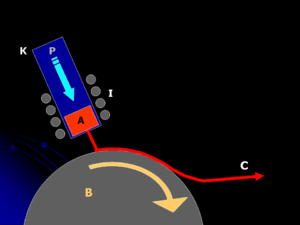Melt spinning

Melt spinning is a technique used for rapid cooling of liquids. A wheel is cooled internally, usually by water or liquid nitrogen, and rotated. A thin stream of liquid is then dripped onto the wheel and cooled, causing rapid solidification. This technique is used to develop materials that require extremely high cooling rates in order to form, such as metallic glasses. The cooling rates achievable by melt-spinning are on the order of 104–107 kelvins per second (K/s).[1]
Chill block melt spinning (CBMS) is a rapid solidification process primarily used for the production of thin metal ribbons. This process has gained wide acceptance as a means of producing amorphous and nanocrystalline materials for several technological applications in electronics.[2][3][4]
Originating with Robert Pond in a series of related patents from 1958-1961 (US Patent Nos. 2825108, 2910744, and 2976590), the current concept of the melt spinner was outlined by Pond and Maddin in 1969, though, at first, liquid was quenched on the inner surface of a drum. Liebermann and Graham further developed the process as a continuous casting technique by 1976, this time on the drum's outer surface.[5] The process can continuously produce thin ribbons of material, with sheets several inches in width commercially available.[6]
References
- ↑ R. W. Cahn, Physical Metallurgy, Third edition, Elsevier Science Publishers B.V., 1983
- ↑ Steen, P.H.; Karcher, C. (1997). "Fluid mechanics of spin casting of metals". Annu. Rev. Fluid Mech. 29 (1): 373–397. doi:10.1146/annurev.fluid.29.1.373.
- ↑ Pavuna, D. (1981). "Production of metallic glass ribbons by the chill-block melt spinning technique in stabilized laboratory conditions". J. Mater. Sci. 16: 2419–2433. doi:10.1007/bf01113578.
- ↑ Pagnola, M.; Malmoria, M.; Barone, M. (2016). "Biot number behaviour in the Chill Block Melt Spinning (CBMS) process". Applied Thermal Engineering. 103: 807–811. doi:10.1016/j.applthermaleng.2016.04.077.
- ↑ Liebermann, H.; Graham, C. (November 1976). "Production of amorphous alloy ribbons and effects of apparatus parameters on ribbon dimensions". IEEE Transactions on Magnetics. 12 (6): 921–923. doi:10.1109/TMAG.1976.1059201.
- ↑ Egami, T. (December 1984). "Magnetic amorphous alloys: physics and technological applications". Reports on Progress in Physics. 47 (12): 1601–1725. doi:10.1088/0034-4885/47/12/002.
External links
- YouTube video of melt spinning process.
- An example of a melt spinner http://www.arcastinc.com/meltspin.htm .